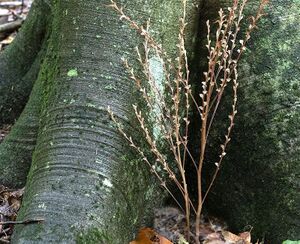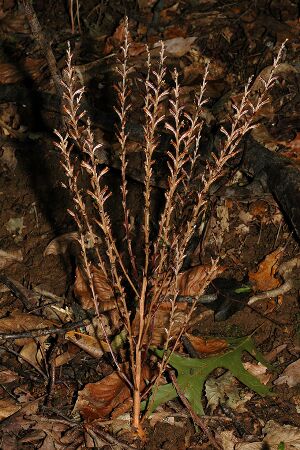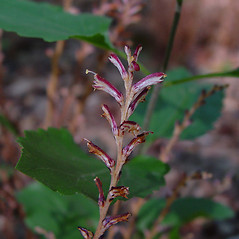Beechdrops: Difference between revisions
| Line 38: | Line 38: | ||
== Host Trees == | == Host Trees == | ||
Beechdrop plants can be found emerging at the base of American beech tree trunks. Beechdrops develop haustorium structures, allowing them to penetrate and grow into beech roots. This is necessary for the purpose of extracting nutrients, as the plants are not able to photosynthesize or produce food without the presence of chlorophyll [1]. Therefore, these parasitic plants depend entirely on beech trees for survival. As the plants mature, the haustorium begins to diminish as an enlarged root tuber develops. Eventually, the parasitic plant and the host tree are connected through their roots and the beechdrops' tubers, instead of through the haustorium [3]. Since beechdrops are an annual flower that completely die off every fall, they have not been observed to cause lasting damage or harm to the host trees. | Beechdrop plants can be found emerging at the base of American beech tree trunks. Beechdrops develop haustorium structures, allowing them to penetrate and grow into beech roots. This is necessary for the purpose of extracting nutrients, as the plants are not able to photosynthesize or produce food without the presence of chlorophyll [1]. Therefore, these parasitic plants depend entirely on beech trees for survival. | ||
As the plants mature, the haustorium begins to diminish as an enlarged root tuber develops. Eventually, the parasitic plant and the host tree are connected through their roots and the beechdrops' tubers, instead of through the haustorium [3]. Since beechdrops are an annual flower that completely die off every fall, they have not been observed to cause lasting damage or harm to the host trees. | |||
== Life Cycle == | == Life Cycle == | ||
Revision as of 01:53, 30 April 2022
Beechdrops (Epifagus virginiana) is an obligate parasitic plant, lacking chlorophyll, that obtains nutrients solely from the roots of American beech trees. The name Epifagus originates from the Greek prefix "epi", translating to "upon", while "Fagus" is the genus name of beech.
Taxonomy
- The genus Epifagus is monotypic, only containing E. virginiana within it.
| Kingdom | Phylum | Class | Order | Family | Genus | Species | |
|---|---|---|---|---|---|---|---|
| Classification | Plantae | Angiosperms | Magnoliopsida | Lamiales | Orobanchaceae | Epifagus, Nutt. | E. virginiana |
Description and Characteristics
Beechdrops averagely reach heights of 6-20 inches (15-50 cm.) at maturity. The plants are generally brown in coloration, commonly being mistaken as woody plants. Beechdrops are herbaceous, however. The stems and branches are skinny; ranging in color from yellow to darker reddish shades of brown, with vertical purple stripes that may darken with age. The leaves are underdeveloped and difficult to distinguish, appearing similar to small scales [2].
The visible flowers are small and tubular, growing alternately along the stems. After blooming in early autumn, between August and October, the flowers are a mixture of deep burgundy and cream [3]. These upper flowers are labeled as chasmogamous, or showy flowers. They grow about one inch long, on average, and are usually sterile. Bumblebees and ants are believed to be the primary pollinators of these chasmogamous flowers. The lower flowers, in contrast, are self-fertilizing and do not open [4]. They are much smaller and more inconspicuous than the showy flowers, also being referred to as secret or cleistogamous flowers.
Host Trees
Beechdrop plants can be found emerging at the base of American beech tree trunks. Beechdrops develop haustorium structures, allowing them to penetrate and grow into beech roots. This is necessary for the purpose of extracting nutrients, as the plants are not able to photosynthesize or produce food without the presence of chlorophyll [1]. Therefore, these parasitic plants depend entirely on beech trees for survival. As the plants mature, the haustorium begins to diminish as an enlarged root tuber develops. Eventually, the parasitic plant and the host tree are connected through their roots and the beechdrops' tubers, instead of through the haustorium [3]. Since beechdrops are an annual flower that completely die off every fall, they have not been observed to cause lasting damage or harm to the host trees.
Life Cycle
A fairly inconspicuous brown stem produces two types of flowers, cleistogamous flowers that self-pollinate without ever opening, and chasmogamous flowers that open, but are often sterile [1]. The roots of the host release a chemical that trigger the germination of E. virginiana. It is believed that the older the host tree, the more this chemical is released. Seeds from E. virginiana are small and are dispersed by rainwater. Between dispersal and germination, seeds experience a cellular change, the embryo changes colors and its cells develop granules.
Habitats and Environment
This parasitic plant is native to North America and can commonly be found along the edges of temperate forests.
Sources
[1] Native Plant Trust: Go Botany. Epifagus virginiana — beech-drops. (nd.). https://gobotany.nativeplanttrust.org/species/epifagus/virginiana/
[2] Beechdrops, Epifagus virginiana, Broomrape family (Orobanchaceae). (nd.). https://illinoiswildflowers.info/woodland/plants/beechdrops.htm
[3] Smith, Hanna. Beechdrops – A Native Parasitic Plant. 2020, October 15. https://guilford.ces.ncsu.edu/2020/10/beechdrops-a-native-parasitic-plant/?msclkid=99aa5e85c80a11ec954348e12a6e822c
[4] Virginia Native Plant Society. A Parasitic Lifestyle: Beechdrops and Their Relatives. 2020, December 16. https://vnps.org/a-parasitic-lifestyle-beechdrops-and-their-relatives/?msclkid=5bd24179c80f11ec9c562ee1da7a1db1


